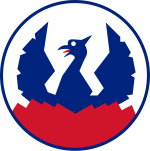| Force 136 | |
|---|---|
 | |
| Founded | 1941 (as India Mission) 1942 (as GSI(k)) 1944 (as Force 136) |
| Disbanded | 1946 |
| Country | |
| Allegiance | Allied forces |
| Type | Wartime intelligence organisation for Far east Special forces[3] |
| Role |
|
| Part of | Special Operations Executive |
| Headquarters | Kandy, Ceylon (now known as Sri Lanka) |
| Mascot(s) | Phoenix |
| Engagements | World War II |
| Commanders | |
| Notable commanders | Colin Mackenzie |
Force 136 was a far eastern branch of the British World War II intelligence organisation, the Special Operations Executive (SOE). Originally set up in 1941 as the India Mission with the cover name of GSI(k), it absorbed what was left of SOE's Oriental Mission in April 1942. The man in overall charge for the duration of its existence was Colin Mackenzie.
The organisation was established to encourage and supply indigenous resistance movements in enemy-occupied territory, and occasionally mount clandestine sabotage operations. Force 136 operated in the regions of the South-East Asian Theatre of World War II which were occupied by Japan from 1941 to 1945: Burma, Malaya, China, Sumatra, Siam, and French Indochina (FIC).[4]
Although the top command of Force 136 were British officers and civilians, most of those it trained and employed as agents were indigenous to the regions in which they operated. Burmese, Indians and Chinese were trained as agents for missions in Burma, for example. British and other European officers and NCOs went behind the lines to train resistance movements. Former colonial officials and men who had worked in these countries for various companies knew the local languages, the peoples and the land and so became invaluable to SOE. Most famous amongst these officers are Freddie Spencer Chapman in Malaya and Hugh Seagrim in Burma.
- ^ Cite error: The named reference
:3was invoked but never defined (see the help page). - ^ Rodriguez, Jeremiah (10 November 2017). "Chinese-Canadian WWII Veterans From Secret Force 136 Honoured in Documentary". HuffPost Canada. Retrieved 16 May 2021.
- ^ "Special Operations Executive". National Army Museum. Retrieved 1 January 2020.
- ^ "Force 136 Historic Marker | Lim Bo Seng's Burial Site". roots.sg. Archived from the original on 11 August 2020. Retrieved 18 March 2020.